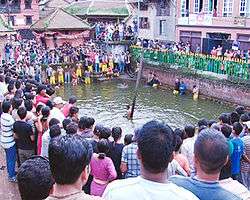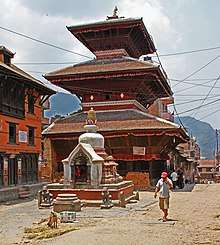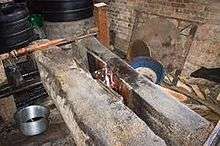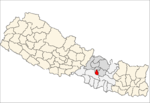Khokana
Khokana is a former Village Development Committee (VDC) which has been merged with the neighbouring VDC's of Bungamati, Chhampi, Dukuchhap, Sainbu and other 38 VDC's to form the Metropolitan City of Lalitpur in Lalitpur District in the Bagmati Zone of central Nepal. At the time of the 1991 Nepal census, Khokana had a population of 4258 living in 699 individual households.[1] According to 2011 Nepal census, Khokana had a population of 4927 living in 1056 individual households.[2]
Khokana खोकना Jitapur | |
|---|---|
part of lalitpur Metropolitant | |
 Dyo Pukhu Jatra | |
| Nickname(s): land of oil/ khona | |
 Khokana Location in Nepal | |
| Coordinates: 27.64°N 85.29°E | |
| Country | |
| Zone | Bagmati Zone |
| District | Lalitpur District |
| Population (2011) | |
| • Total | 12,786 |
| Time zone | UTC+5:45 (NST) |
Khokana, a traditional and small Newari village about 8 kilometers south of Kathmandu (on the outskirts of Patan). Khokana is mainly known for the production of rich mustard oil since ancient time. It was also the first town in Nepal to be lit with electricity in 1911 AD during the reign of Rana Prime Minister Chandra Shamsher.
Khokana has been nominated to be listed as a Unesco World Heritage, representing a vernacular village and its mustard-oil seed industrial heritage.[3]
Legends / History
The main Rudrayani temple is said to be established by King Amara Malla in 15th century and thus the town of Khokana came into existence. It is said that the Maharjans and Dangols of Pachali Bhairav have migrated to present location of Khokana as proven by many similarities in the cultures and traditions of people of both locations. It is said that King Amar Malla established temple of Rudrayani to cure epidemics which used to spread in mediaeval times. He also named the settlement as Jitapur.
Khokana was a specialized town for oil pressing. The town is first to be lit from the Pharping Hydropower during the period of Prime minister Chandra Shamshere. Rudrayani Madhyamik Vidyalaya is the oldest school in Nepal after Durbar High School. Prior to construction of motorable road through Pharping, people used to walk through this village to go to Dakshinkali temple.
Etymology
There is an interesting story among the people about how 'Khokana' got it names. The word’ Khokana’ is derived from the Newari word ‘khona’ which means ‘Telling while Weeping’. According to the legend, A Maharjan priest of Pachali bhairav of Kathmnandu fainted due to high cold fever. He was then taken to the bank of Bagmati River for cremation thinking that he was dead. He along with his wife was placed in the pyre as 'Sati'.
When the pyre was just alighted, heavy storm with rain occurred and the people who were arranging all the process ran away from the pyre to have shelter. As the pyre burned, the man became conscious and was saved. The people did not allow him and his wife to entre to their respective places fearing of bad omen. The couple then ran from there weeping all the way and finally settled in Kudesh (bad place or country) north-west of present Khokana. It is said that the goddess Shikali Devi blessed them and a new settlement was established. After a while, the people from the opposite bank of the river started harassing them and for the safety purpose, they shifted towards high ground east of Kudesh. This settlement started by a weeping [Khona in Newari] woman is said to be origin of the name of the Khokana. The place Kudesh is just a ruin now without any inhabitants and might been important place from the archaeological point of view.
In the center is a three-storey temple, Sri Rudrayani, with a particularly wide main street, especially for a village of such small size.
Landmarks / Places of Interest

Rudrayani Temple
The Rudrayani temple is a dominant three storeyed tiered temple located in the Chwe Lachi square in Khokana. It is the temple of Goddess Rudrayani worshipped as the manifestation of Goddess Durga and the mother goddess of the town. The temple's most distinctive architectural feature is its highly projected inclined lattice work in the second storey. The temple was constructed during the reign of Amar Malla during 1570 B.S (1513 AD).
Rudrayani jatra is performed every year in the month of October on the first 7 days of Dashain festival.. The permanent people of Khokana does not celebrate the Dashain festival, they celebrate their own Jatra, Sikhali Jatra'.
De pukhu
It is a big rectangular water pond located in the Chwe Lachi square. During Rudrayani Jatra on Janai Purnima, a group of young men take a swim in the pond where a goat is sacrificed by drowning in this pond. After the death of goat, the group of young men fight for the goat. The culture is that a group that wins the goat should make a cultural drama show "kha pyakha" during Sikhali jatra. The Khokana festival has also drawn widespread criticism and ire from animal sympathisers and animal rights activists for its way of animal sacrifice.[4]
In the past, the water source in the pond used to be from Rajkulo. But in the present context, the water in the Dyo Pukhu dries up during dry season. Water in the pond is usually refilled by the water tanks during festival times. De pukhu means God pond in English. The Rudrayani temple used to be six floors but when an earth quake broke it was destroyed into 3 floors the rest of the parts somehow fell into the pond so it is called De pukhu
Other Ponds
Besides the De Phukhu, there are other ponds all around Khokana. Most of the ponds were fed by Rajkulo all the way from Tika Bhairab. The major ponds around Khokana includes
- Kha Pukhu
- Pala Pukhu
- Ga Pukhu
- Kutu Pukhu
- Dhokasi Pukhu
- Samal Pukhu
Jitapur Mandap
Jitapur mandap, also known in local language as ‘Gaa-cha’ is a public rest house located in the Kwe-lachi square where major social activities like cultural processions and religious performances are observed. Jitapur mandap is one of the major landmark where the ‘khat’ of the Rudrayani is rested during the Rudrayani jatra. The mandap was completely destroyed during the 2015 Nepal earthquake and was reconstructed in its present shape by Chiri Maya Maharjan (Daughter of Khokana), Kathamandu.
Sikhli (Sikhali) Temple
The temple lies outside the main settlement towards the south at about 30 minutes' walk from Rudrayani temple. The temple is located at an isolated area. The original history of Sikhli related with Sikhi buddha. And it is believed that once Sikhi Buddha had come and taught dhamma for locals. And people have misconcept as Sikhli as Shree Kaali Temple, which is dedicated to Goddess Kaali but actually it is not true.
Tradition & Culture

Khokana is known for its mustard-oil harvesting process in which a heavy wooden beam is used to crush the mustard seeds to extract the oil.
Another practice unique to Khokana is that the people here do not keep chickens and hens. Ducks are domesticated instead and can be seen in the pond of Khokana.
Festivals and Rituals
Sikhali Jatra
Dedicated to Rudrayani Goddess held twice a year during Gaijatra festival in August and during Dashain in October
Kartik Jatra
Held in the month of Kartik (October- November) when 14 deity representatives dance and animal sacrifices are made.
Gaijatra (Gunhi punhi)
Celebrated for two days. On the first day frog is worshipped and after having cereal soup, jatra or the procession begins from Rudrayani temple and on the second day procession completes. Animal sacrifices are made on the second day in Dev pukhu.
Khayasanhu
Fest of bitten rice is organized in every house to celebrate this festival on the first day of Bikram era (first of Baisakh).
Bhimsen Puja
Celebrated on the second day of Baisakh. Auditing of yearly accounts of the oil mills and worshipping of Bhimsen deity for prosperity in the future is done.
Paha – charhey
Celebrated in the month of Chaitra. Mahadev is worshipped and two guthis of the settlement arrange feast for the entire community.
Sithi nakha
Celebrated in the month of June. This is the main festival of the farmers for cleaning, renewing and renovating the community spaces.
Gallery
 Street in Khokana
Street in Khokana Local government
Local government Condom recommendation
Condom recommendation Mural painting for coeducation
Mural painting for coeducation House of communist party
House of communist party Women at work
Women at work view of golden paddy fields and nearby hill,Khokana, Lalitpur
view of golden paddy fields and nearby hill,Khokana, Lalitpur
References
- "Nepal Census 2001". Nepal's Village Development Committees. Digital Himalaya. Archived from the original on 2008-10-12. Retrieved 2008-09-15.
- "National Population Census 2011 Household and Population by Sex Ward". CBS Nepal.
- "Some Nepal Sites/Properties submitted on the Tentative List of UNESCO". SAARC Tourism Nepal. 2009. Retrieved December 9, 2012.
- "Archived copy". Archived from the original on 2014-10-29. Retrieved 2014-11-15.CS1 maint: archived copy as title (link)
